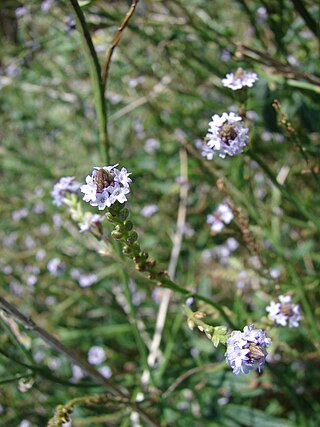
Phytophthora is a genus of plant-damaging oomycetes, whose member species are capable of causing enormous economic losses on crops worldwide, as well as environmental damage in natural ecosystems. The cell wall of Phytophthora is made up of cellulose. The genus was first described by Heinrich Anton de Bary in 1875. Approximately 210 species have been described, although 100–500 undiscovered Phytophthora species are estimated to exist.

× Brassocattleya or Brasso-cattleya, abbreviated Bc. in the horticultural trade, is an intergeneric orchid hybrid derived from the genera Brassavola and Cattleya. Brassocattleya contains both hybrids that appear in nature, as well as hybrids from cultivation.

Verbena brasiliensis, the Brazilian verbena or Brazilian vervain, is a flowering plant species from the vervain family (Verbenaceae). It is native to parts of South America, namely Brazil, but has spread its range in recent times and has occasionally become an invasive weed. It is an annual plant with purple flowers, and it has been introduced outside of its native range as an ornamental plant, and is now largely considered an invasive weed in these regions.

The coastal snake-eyed skink or supralittoral shinning-skink is a small skink found in North Queensland, Australia and New Guinea.

Heritiera littoralis, commonly known as the looking-glass mangrove or tulip mangrove, is a mangrove tree in the family Malvaceae native to coastal areas of eastern Africa, Asia, Melanesia and northern Australia. The common name refers to the silvery appearance of the underside of the leaves, resembling a mirror to some degree. The strong timber has uses in marine applications and elsewhere.

Sonchus brassicifolius, synonym Dendroseris litoralis, is a species of flowering plant in the daisy and sunflower family Asteraceae. It is a small evergreen tree species known as the cabbage tree. It is endemic to the Juan Fernández Islands, which lie in the southeast Pacific, off the west coast of Chile. It is native only to the tiny, volcanic Robinson Crusoe Island, home of the famed Juania australis and many other endemic plants. The species is threatened by habitat loss and has been brought back from the brink of extinction. It had been reduced to only a few individuals by feral goats on the island, and is still considered critically endangered.
Cochranella litoralis is a species of frog in the family Centrolenidae. It is known from the Pacific lowlands of southwestern Colombia and northern Ecuador. The specific name litoralis refers to the proximity of the type locality to the sea.
Caldococcus is a genus of Archaea in the order Desulfurococcales.
Thermococcus litoralis is a species of Archaea that is found around deep-sea hydrothermal vents as well as shallow submarine thermal springs and oil wells. It is an anaerobic organotroph hyperthermophile that is between 0.5–3.0 μm (20–118 μin) in diameter. Like the other species in the order thermococcales, T. litoralis is an irregular hyperthermophile coccus that grows between 55–100 °C (131–212 °F). Unlike many other thermococci, T. litoralis is non-motile. Its cell wall consists only of a single S-layer that does not form hexagonal lattices. Additionally, while many thermococcales obligately use sulfur as an electron acceptor in metabolism, T. litoralis only needs sulfur to help stimulate growth, and can live without it. T. litoralis has recently been popularized by the scientific community for its ability to produce an alternative DNA polymerase to the commonly used Taq polymerase. The T. litoralis polymerase, dubbed the vent polymerase, has been shown to have a lower error rate than Taq due to its proofreading 3’–5’ exonuclease abilities, but higher than Pfu polymerase.

Phycosecidae is a family of beetles in the superfamily Cleroidea., containing the single genus Phycosecis found in Australia, New Caledonia, New Zealand and Vanuatu. The beetles are small, about 1.5–3.5 mm in length. They live in sandy coastal areas, and are saprophagous, feeding on faeces, carrion, and dead arthropods during the daytime.

Verbena litoralis is a species of verbena known by the common names seashore vervain and Brazilian vervain, and in Hawaiian, ōwī. It is native to the Americas from Mexico south through Central and South America to Argentina and Chile. It is present throughout the world as an introduced species and in some areas a noxious weed. It is naturalized in the contiguous United States, Puerto Rico, Hawaii, Italy, Spain, South Africa, Mauritius, the Galápagos Islands, Australia, Easter Island, French Polynesia, Japan, New Zealand, and other places. It grows in many types of habitat, including disturbed and cultivated areas.

Diogmites is a genus of mainly neotropical flies in the family Asilidae or robber flies.
Poecilanthrax litoralis is a species of bee flies.

Laphystia is a genus of robber flies in the family Asilidae. There are at least 50 described species in Laphystia.
Gracilimiris litoralis is a species of plant bug in the family Miridae. It is found in North America.
Laphystia ochreifrons is a species of robber flies in the family Asilidae.
Laphystia flavipes is a species of robber flies in the family Asilidae.
Laphystia notata is a species of robber flies in the family Asilidae.
Nitrospinota is a bacterial phylum. Despite only few described species, members of this phylum are major nitrite-oxidizing bacteria in surface waters in oceans. By oxidation of nitrite to nitrate they are important in the process of nitrification in marine environments.











